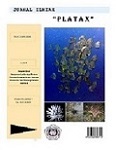CO2 Absorptibility of Seagrass, Enhalus acoroides, From Tongkaina Coast, North Minahasa, North Sulawesi Province
DOI:
https://doi.org/10.35800/jip.4.1.2016.13454Abstract
ABSTRACT
Climate change results from increase in green house effect and particles in the atmosphere. It comes from 1) fossil fuel combustion, green house gas removals, such as CO2, called “brown carbonâ€, and dust particles called “black carbonâ€; 2) emission from forest vegetation clear cut, forest fire, and agricultural activities (fertilizer); 3) low ability of the natural ecosystem to absorb carbon in photosynthesis and store it called “green carbonâ€.
Seagrass can function to absorb CO2 in photosynthesis that produces biomass providing important storage of carbon. Carbon held in a vegetation is separated into aboveground carbon and underground carbon.
CO2 absorptibility measurement used carbohydrate method. This measurement was aimed to know the ability of the seagrass, E. Acoroides, to absorb CO2 through the carbohydrate content of the leaf. Results showed that CO2 absorptibility per individual of E. acoroides was 0.50 g and the net absorptibility was 145.5 (g/Ha/hour.
Keyword: seagrass, CO2, E.acoroides
ABSTRAK
Perubahan iklim disebabkan karena meningkatnya kandungan gas rumah kaca dan partikel di atmosfer. Pertama, disebabkan karena pembakaran bahan bakar fosil, pelepasan gas rumah kaca seperti CO2, dikenal sebagai “brown carbonâ€, dan partikel debu, dikenal sebagai “black carbonâ€. Kedua, disebabkan karena emisi yang berasal dari penebangan vegetasi hutan, kebakaran hutan, dan emisi dari kegiatan pertanian (pupuk). Ketiga, disebabkan karena pengurangan kemampuan ekosistem alami untuk menyerap karbon dalam proses fotosintesis dan menyimpannya, dikenal sebagai “green carbonâ€.
Lamun dapat berperan dalam menyerap CO2 dalam proses fotosintesis. Fotosintesis pada lamun tersebut menghasilkan biomassa yang menyediakan simpanan penting karbon. Cadangan karbon yang tersimpan pada suatu vegetasi terbagi menjadi karbon di atas permukaan (above gound carbon) dan karbon yang berada di bawah permukaan atau dalam tanah (below gound carbon).
Pengukuran daya serap CO2 dalam penelitian ini menggunakan metode karbohidrat Pengukuran ini dilaksanakan dengan tujuan untuk mengetahui kemampuan tumbuhan lamun E. acoroides yang ditemukan di lokasi penelitian dalam menyerap CO2 melalui kandungan karbohidrat daun. Hasil yang didapatkan adalah daya serap CO2 per individu E. acoroides adalah 0,50 g dan daya serap bersih per hektar luas lahan (E. acoroides 145.5 (g/Ha/jam).
Kata Kunci: Lamun, CO2, E.acoroides
1Staf pengajarFakultasPerikanandanIlmuKelautanUniversitas Sam Ratulangi
Downloads
Published
How to Cite
Issue
Section
License
COPYRIGHT
Authors who publish with this journal agree to the following terms:
Authors hold their copyright and grant this journal the privilege of first publication, with the work simultaneously licensed under a Creative Commons Attribution License that permits others to impart the work with an acknowledgment of the work's origin and initial publication by this journal.
Authors can enter into separate or additional contractual arrangements for the non-exclusive distribution of the journal's published version of the work (for example, post it to an institutional repository or publish it in a book), with an acknowledgment of its underlying publication in this journal.
Authors are permitted and encouraged to post their work online (for example, in institutional repositories or on their website) as it can lead to productive exchanges, as well as earlier and greater citation of the published work (See The Effect of Open Access).






































